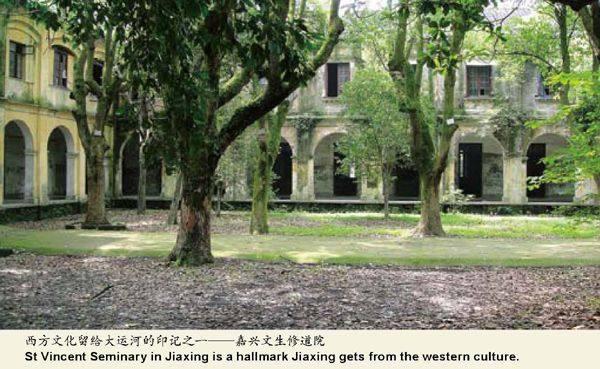中国大运河:中外文化交流走廊
2013-04-29魏大锅
魏大锅



大运河是一条中外文化交流走廊。交流时间之长,地域跨度之大,影响力度之深,是中国文化历史上值得书写的重要篇章。
历史上,中国大运河是一条中外文化交流的走廊。在这条走廊里,交流是双向的:早期,主要是中国文化输出;后半期,则是外国先进文化输入。
大运河的输出
在举世闻名的《马可·波罗游记》中,马可·波罗(1254-1324)描述了他看到的长江以北运河:忽必烈已经开通了从瓜洲到大都的水路。这条水路是一条宽而深的航道,把江河、湖泊连接起来。《游记》还记录了他在山东一带看到的运河城市如临清、济南和东平等地的情况。
近代西方人进入中国、并对中国逐渐产生影响,最早大约可以追溯到明代。这个节点与世界历史的发展有关。史学家一般把哥伦布1492年第一次航海当作中世纪和现代的转捩点。此后,西北欧沿海强国通过战争、掠夺、贸易、传教、建立殖民地等方式逐渐向外扩张。至19世纪,欧洲在文化、政治、经济、军事等各方面迅猛发展。而明清时期的中国早已繁华,举世闻名,引发了西方人的关注,当时外国人来中国,首先接触的往往就是大运河。前往北京的外国使节、传教士、旅行者等多取道于此。大运河沿线的水利工程、城镇乡村和风土民情,给外国人留下了深刻印象,他们的作品中的观察与描述无疑有助于西方加深对中国的认识。
1488年,朝鲜人崔溥(1454-1504)在海上遭遇风浪,漂流14天后在宁波附近获救登岸。之后,他沿浙东运河、京杭运河前往北京,历时44天,成为明代走完大运河全程的第一个朝鲜人。他用中文写下的《飘海录》成为弥足珍贵的大运河史料。
日本僧人策彦周良(1501-1579)于1539年和1547年作为日本遣明使副使和正使来中国,在中国逗留5年多,多次沿大运河南来北往。他将两次来华经历写成《初渡集》《再渡集》。这两本记事性诗文集是中日关系史上的重要文献。
意大利耶稣会传教士利玛窦(1552-1610)在明万历年间来中国。他从南京出发沿运河前往北京,沿途经过许多大运河城市。对明代运河漕运的有关情况,他甚感兴趣,在《利玛窦中国札记》中做了详细记载。
除了利玛窦之外,明清时期有不少来中国的传教士将他们在中国的所见所闻写成书,在欧洲出版,其中不乏关于大运河的详细描述。这一时期还有不少中国传统典籍经翻译而介绍到欧洲。英国传教士、汉学家理雅各(1815-1897),是牛津大学第一位中国语言和文学教授。他不仅翻译中国典籍,还著书立说,系统论述孔子、孟子以及中国的文学和宗教。在牛津任职之前,他于1873年4月从上海出发,坐船经大运河访问北京,回程时去了泰山和曲阜,之后经大运河返回上海。他对中国文化的译介,可以听到大运河的水声。
但外国人对大运河的描述,并非仅限于见闻。他们目的性很强,颇有系统性,撰写专门报告,研究大运河,研究大运河对中国的政治、经济、文化的影响。
英国学者吉恩斯在1890年在伦敦出版《世界各国的水道和水运》中提到中国的大运河,认为“就许多方面来说,世界上最值得注意的是中国的大运河。它也是所有其他运河中,我们了解最少的。”1895年出版的《时代世界地图集》中载有中国大运河的地图。1912年10月,美国《国家地理杂志》刊登F.H.金的学术论文,题目是《中国的运河,人类的奇迹》,该文对江南运河地区河网密布做了详细的记录。1917年在伦敦出版的《百科全书,中国》有关于大运河的词条。
大运河的接纳
通过大运河,西方对中国有所了解。而现代西方文化最早进入中国,所谓西风东渐,正是沿着大运河而播扬。
法国传教士金尼阁(1577-1628)在利玛窦逝世后不久抵达北京,并发现了利玛窦的札记。明万历四十年(1612),金尼阁返回欧洲,他身着中式服装出入于各国公共场合,以感人肺腑的演讲宣传利玛窦和其他在华传教士们的功绩,并着手整理翻译《利玛窦中国札记》。该札记于1615年在德国出版,掀起了欧洲的“中国热”。当时,大批欧洲年轻传教士申请赴华,德国人汤若望(1592—1666)即是其中的一位。汤若望历经明清两代,为西学东渐做出重大贡献。1618年,金尼阁离开里斯本第二次来华时,携带在欧洲各国募集的7000册图书和仪器,从杭州沿大运河抵达北京,建立了中国第一个外国图书馆。金尼阁本人估计书籍和仪器在离开欧洲时价值1万金币。金尼阁拟定了一个庞大的计划,联络艾儒略、徐光启、杨廷筠、李之藻、王徵、李天经等中外人士共同翻译出版这些书籍。金尼阁二度来华后,先在南方进行传教和译著工作,较长时间住在杭州,并以杭州为中心沿大运河到嘉定等地活动。1628年,金尼阁在杭州去世,把“西书七千部”介绍给中国知识界的计划流产,大部分书籍流失。1938年,北平天主教堂整理藏书楼时发现了残存的数百部,其中有哥白尼的《天体运行论》和开普勒的《哥白尼天文学概要》等重要的科学典籍。
鸦片战争之后,外国传教士大量进入中国。在19世纪末20世纪初,浙北的运河城市早已成为一些外国传教士在中国活动的基地和大本营。嘉兴的文生修道院西临大运河,1902年建成之后到1908年,它是天主教中国遣使会的唯一总修院。嘉兴的天主教堂在1930年建成,号称中国第一、远东第三大教堂。文生修道院和天主教堂均为浙江省省级文物保护单位。
曾经担任美国驻华大使的司徒雷登(1876-1962),出生在杭州。父母均是美国南长老会在杭州的传教士。南长老会海外传教的第一个基地是杭州,以后沿大运河逐步向嘉兴、苏州、江阴、南京等地扩展。1904年,司徒雷登在美国结束学业,回到杭州开始传教,他的传教足迹正是沿大运河迤逦北去。
19世纪后半期起,大运河沿岸城市建立了相当数量的教会学校。教会学校最直接的贡献就是把现代教育模式移植到了中国。经过多年经营,在整个20世纪上半叶,13所教会大学和几十所教会中学为中国融入现代文明、为教育和社会的现代化作出了重大贡献。而这些学校中相当一部分位于大运河沿线的城市或者与运河关系甚为密切的城市。
教会大学各校名师云集,各有自己的个性和特殊专业,办学有声有色,学生才俊辈出。燕京大学的社会学系和新闻系,在全世界都有影响力。在二战后的“东京审判”中,中国法官中的大部分都是毕业于东吴大学。医科更是教会大学的强项,协和医学院、湘雅医学院以及齐鲁大学的医科,为中国培养了最优秀的医学人才。
1901年,清政府废除漕运,大运河似乎失去了历史作用,但因为依靠大运河为广阔腹地而有机会迅速成为中国最大港口和最繁华城市的上海,中外文化交流在20世纪结出硕果。
很多人惊异于19世纪末20世纪初江浙一带大量涌现文人政客这一现象,细究起来,却不难看出大运河的作用。正是大运河使得整个地区经济繁荣,积聚起深厚的文化底蕴,从而使得中外文化交流得以在各个层面广泛深入进行,人才辈出是理所当然的。
(除署名外,本文图片由作者提供)
Grand Canal: Corridor of International Cultural Exchanges
By Wei Daguo
Historically, the Grand Canal of China served as a corridor of international cultural exchanges. The exchanges were mutual: in the early centuries, Chinese culture went out to the outside world; largely in the Ming (1368-1644) and the Qing (1644-1911) dynasties, foreign cultures began to come in.
Prosperity of the Grand Canal
One of the earliest description of the Grand Canal of China was made by Marco Polo (1254-1324), who traveled across China for years. He mentioned the Grand Canal that connected the Yangtze River and Dadu, the present day Beijing, the capital of the Yuan Dynasty (1279-1368). There are detailed descriptions in the travelogue about the canal towns in Shandong Province.
It was in the Ming Dynasty that westerners began to flood into China on a large scale. Their arrival in China followed Columbus epoch-making travel. Afterwards, the west expanded outward through wars, trade, religious missions, colonialism, profits through looting. By the 19th century, Europe played a big role in the world. Europeans came to China, allured by the legendary wealth of China. During these centuries, foreign diplomatic envoys, missionaries, and travelers usually traveled on the Canal to reach Beijing. They were deeply impressed by the size and the grandeur of the Grand Canal. Their reports deepened the western understanding of the great country in the orient.
The Italian missionary Matteo Ricci (1552–1610) came to China during the reign of Emperor Wanli of the Ming. He traveled on the Grand Canal from Nanjing to Beijing and chronicled his canal tour in detail in his book. In addition to Matteo Ricci, other missionaries also wrote books and introduced their China experiences to Europe. Some missionaries even provided Europeans with translations of Chinese classics. James Legge (1815-1897), a noted Scottish sinologist and missionary in Malacca and Hong Kong for 33 years and first professor of Chinese at Oxford University for 21 years. He translated Chinese classics into English and wrote books on Confucius and Mencius as well as Chinese literature and religion. Before he took office at Oxford, he started in April 1873 in Shanghai to visit Beijing. He traveled on the Grand Canal. On his way back, he visited Mount Tai and Confucius Temple. Then he traveled on the Canal again on his way back to Shanghai.
By the late 19th century and early 20th century, the Grand Canal of China had become a constant subject in encyclopedias, map atlases, and academic books published in the west.
Western Culture Came In
While information on the Grand Canal went abroad, westerners brought western culture into China. In China scholars describes the phenomenon through the Ming, the Qing and the Republic years in words “Western Winds Blow into East.” The Grand Canal played a big role in this cultural exchange between east and west.
Nicolas Trigault (1577-1629) arrived in Beijing shortly after Matteo Ricci passed away. A French missionary and sinologist, he was an influential westerner in China. He toured China before going back to Europe to report to the Pope on missionary affairs in China. In 1612, he returned to Europe. He traveled across Europe, publicizing the work of the Jesuit missions in China and raising funds. He appeared in public dressed in the Confucian gown. It was during his European tour that he edited and translated Matteo Riccis China Journal. The work was published in Augsburg in 1616 and later it was translated into many European languages and widely read. Twenty-two young missionaries followed him back to China. Johann Adam Schall von Bell (1591-1666) was one of the 22 missionaries. He served the emperors of the Ming Dynasty and the Qing Dynasty.
Nicolas Trigault brought 7,000 books and instruments to China and traveled on the Grand Canal all the way from Hangzhou to Beijing. He set up the first foreign library in China. He planned to translate the books into Chinese in collaboration with a group of elite Chinese scholars. He died in Hangzhou in 1628 and he was buried in Hangzhou. His translation project aborted and most of the books dissipated. In 1938, hundreds of books were found in a library of a Catholic church in Beijing. These books were part of the 7,000 books Trigault had brought to China.
After the Opium War in the mid 19th century, missionaries flooded into China. In the late 19th century and early 20th century, canal cities and towns in northern Zhejiang were home to headquarters of some foreign missionaries in China. St. Vincent de Paul Seminary, a Catholic abbey in Jiaxing, served as the only seminary for all the missionaries in China from 1902 to 1908. The Catholic Church in Jiaxing, built in 1930, was the largest church in China and the third largest in Far East at that time. The two sanctuaries are now cultural relic units under provincial protection.
John Leighton Stuart (1876-1962) was the first President of Yenching University and later United States ambassador to China from 1946 to 1949. Born in Hangzhou in 1876, he was son of Presbyterian missionary parents based in Hangzhou and reached out to believers around Hangzhou and areas along the Grand Canal north of Hangzhou. John Leighton Stuart grew up on Hangzhou and spoke the local dialect. After he finished education in the United States, he came back to Hangzhou and started missionary work in 1905. His constituents were residents in canal towns and villages.
From the late 19th century, church schools in canal towns and cities mushroomed, contributing to the modernization of education in China. In the first half of the 20th century, there were 13 universities, dozens of schools in the primary and secondary education founded and operated by foreign churches. The majority of these schools were situated in canal towns and cities or cities closely associated with the Grand Canal. Church-associated universities turned out talents in various fields and these graduates played a big role in the modernization of China in the 20th century.
The Grand Canal went out of fashion in 1901 when the Qing government aborted the centuries-old tributary system. However, the Grand Canal continued to play a big part in regional economy in eastern China. Shanghai, which grew out of nothing after the Opium War, rapidly became an international metropolis in the early 20th century. Given its geographic position in the canal area, Shanghais rise to the international status was closely associated with the Grand Canal. When one examines the cultural history of the Yangtze River Delta in the late 19th century and early 20th century, one would wonder why there was a galaxy of cultural celebrities in the region. They all came from the canal region, enriched and shaped by cultural exchanges between China and the outside world made possible by the Grand Canal.
